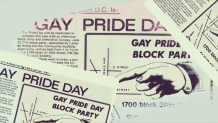LGBTQIA+ Pride Month is steeped in a deep history of protest, parties and parades, stemming back to the Stonewall uprising in New York, which became the cradle of the modern gay rights movement.
Up to a half-million people gather in Washington, D.C., for Pride Month events.
To understand how it all started, you have to go back almost 50 years to a small block on 20th Street NW where Deacon Maccubbin was living his life out loud.
We've got the news you need to know to start your day. Sign up for the First & 4Most morning newsletter — delivered to your inbox daily. >Sign up here.
Maccubbin owned Lambda Rising, one of the few gay bookstores in D.C.
"We always, every year, went to New York for their pride celebration,” Maccubbin said. “But why don't we ever hold something here in Washington? And I thought, ‘Oh, that's a wonderful idea.’"
That idea sparked a celebration that would forever change the queer community in the District.
But first, Deacon had to get permission from everyone on the block to close the street.
"We only had one person on the block who refused to sign the petition, which was pretty wonderful back in 1975,” Maccubbin said.

"Gay Pride Day" was held on June 22, 1975. It was the first officially recognized Pride celebration in D.C.
"It was a smidgen of what we think of as Pride today, but a wonderful smidgeon,” Maccubbin said.
A few booths, some music and food were the main draws — but 2,000 people showed up. Right then, Maccubbin said he knew it would be an annual event.
Lou Chibbaro, who reports for the Washington Blade, was there that day. He said that back then, attending was a risk for many people who weren't out.
"Some, I remember them telling me that, gee, if my boss were to see me, I could get fired. And many were not out to their families as well, and they were worried about television coverage,” Chibbaro said.
Despite those fears, the crowds grew. Within five years, more than 10,000 people attended an event spread over three blocks, according to Capital Pride.
Festivities outgrew the space on 20th Street NW and moved to larger spaces. By 1980, a new committee was formed to host the festival near 24th and N streets NW. The next year, it was renamed the "Gay and Lesbian Pride Day," Capital Pride said.

It moved downtown to Freedom Plaza in the '90s and eventually in front of the U.S. Capitol. The Whitman-Walker clinic took over in 1997 and renamed the event Capital Pride.
Celebrations have returned to Pennsylvania Avenue for more than 20 years, said former Capital Pride President Bernie Delia. During that time, the Capital Pride Alliance became its own organization.
"I think we recognize, sort of, the responsibility that we have as the nation's capital,” Delia said. “The eyes of the world are on us."
Although Lambda Rising closed in 2009, the original location is not left out. This year, the Capital Pride Parade will end just past 20th Street NW, and a block party will bring revelers back — full circle, close to where it all began.
That original event has led to many other Pride events over the years, including Youth Pride, Silver Pride and the nation’s first Black Pride.
Kenya Hutton, with the Center for Black Equity, is impressed at how far Black Pride has come.
"It has grown from just coming here on this field to now, you know, celebrities and major companies. And everyone wants to be a part," Hutton said.
There's also AAPI [Asian American Pacific Islander] Pride, Latino Pride and Trans Pride.
Former Capital Trans Pride Chair Bianca Rey said the event has grown from a small group of friends who wanted to be with each other to a multiday conference with networking and entertainment.
The local movement that started 48 years ago on one block continues to grow.
"There's always a need for a community, for people to have a place they can go to to be with their people,” Maccubbin said.
Sophia Barnes contributed to this report.



